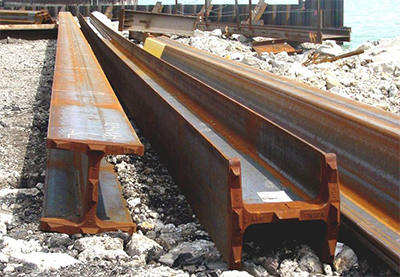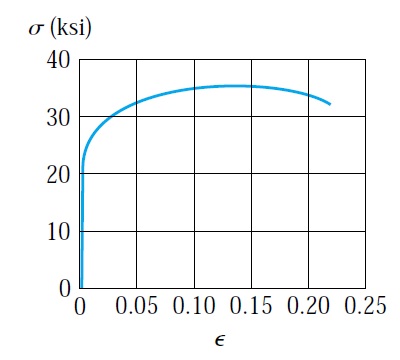Driven piles
Driven piles have been used widely as a foundation for different structures. In this type of foundation. Piles are driven to soil mechanically using a hammer. There are enormous types of driven piles.
- Steel H Piles
Section of H-pile consists of flange and web, as shown in figure no:1. They are driven using a high impact hammer, and the likelihood of pile damage is low. H-piles resists the loads through skin friction or end bearing or both. Since the displacement of soil is minimal, this type of piles can be driven into dense granular soil or stiff clay layers. Although some problem during driving may arise. Plugging is one of them. After driving the pile to a certain level. soils will adhere to pile web and between the flange creating a closed end. This will change the pile to displaced pile and complicate pile driving.
H-piles should be protected against corrosion by suitable methods such as coating, jacketing with concrete, metallization, or cathodic protection. Corrosion can adversely affect H-piles by reducing streel section, and this will reduce the capacity of H-piles which may lead to settlements or structure failure

Prestressed concrete piles are more durable than reinforced concrete. Prestressing of concrete limits the crack and this, in turn, will eliminate corrosion and weathering. Prestressed concrete piles section varies from square to octagonal. Voids used for the large section to reduce member self-weight and facilitate handling and transportation.
Pretensioned or post-tensioned can be used to prestress piles. In general pre-tensioned piles are casted to their full length in permeant casting bed. Post-tensioned piles are divided into section then assembled and prestressed at site job.
Driving prestressed concrete piles in hard strata can lead to pile damage due to the reduction in axial compression strength as a result of applying prestressing force.
Installation of driven piles
Drop hammer should not be used for concrete piles or if the ultimate pile capacity exceeds 55 tonnes. Ram weight shall be equal or more than the combined weight of pile and helmet for the pile.
Diesel hammers divided into single acting and double acting diesel hammer. In a single-acting hammer. The hammer lifted by crane then released to fall freely inside the cylinder. At the same time, the fuel injected to the combustion chamber beneath the ram. One the ram hit the anvil of pile it will ignite the pressurized mixture of fuel and air. The energy of fuel will push the ram back, and the process will continue until the pile is driven. The velocity of impact or stroke measurement should be recorded.
The double acting hammer has a similar mechanism. However, there is a slight difference from the single acting hammer. The end of the system in double acting hammer is closed. Recording the pressure of the bounce chamber or stroke with blow count is critical, and it should not be missed
Driving Appurtenances
The cushion should be used for all hammers expect drop hammer or hammers in which design not requiring cushion. Materials used in produced cushion shall be durable materials so it will not deteriorate during driving piles. Moreover, the hammer cushion shall be housed with a striking plate. So the compression pressure distribution will be uniform on hammer cushion. Hammer cushion should be replaced in case the reduction of thickness exceeds 25% of the original thickness or as per manufacturer recommendation.
Using cheap hammer cushion will result in the error of estimating ultimate pile capacity. Also, it may damage the pile.
 |
| Figure 1 |

- Prestressed concrete piles
Prestressed concrete piles are more durable than reinforced concrete. Prestressing of concrete limits the crack and this, in turn, will eliminate corrosion and weathering. Prestressed concrete piles section varies from square to octagonal. Voids used for the large section to reduce member self-weight and facilitate handling and transportation.
Pretensioned or post-tensioned can be used to prestress piles. In general pre-tensioned piles are casted to their full length in permeant casting bed. Post-tensioned piles are divided into section then assembled and prestressed at site job.
Driving prestressed concrete piles in hard strata can lead to pile damage due to the reduction in axial compression strength as a result of applying prestressing force.
 |
| Figure 2 |
Installation of driven piles
Driving Appurtenances
Different types of hammers used to drive piles. The size of the hammer shall be sufficient to provide enough energy to drive piles at normal operating condition. Supposing a dense layer of soil encountered then hammer can be operated at a higher level to enable pile to penetrate the soil.
- Hammers
Different types of hammers used to drive piles. The size of the hammer shall be sufficient to provide enough energy to drive piles at normal operating condition. Supposing a dense layer of soil encountered then hammer can be operated at a higher level to enable pile to penetrate the soil.
- Drop hammers
Drop hammer should not be used for concrete piles or if the ultimate pile capacity exceeds 55 tonnes. Ram weight shall be equal or more than the combined weight of pile and helmet for the pile.
- Diesel hammers
Diesel hammers divided into single acting and double acting diesel hammer. In a single-acting hammer. The hammer lifted by crane then released to fall freely inside the cylinder. At the same time, the fuel injected to the combustion chamber beneath the ram. One the ram hit the anvil of pile it will ignite the pressurized mixture of fuel and air. The energy of fuel will push the ram back, and the process will continue until the pile is driven. The velocity of impact or stroke measurement should be recorded.
 |
| Figure 3 |
The double acting hammer has a similar mechanism. However, there is a slight difference from the single acting hammer. The end of the system in double acting hammer is closed. Recording the pressure of the bounce chamber or stroke with blow count is critical, and it should not be missed
 |
| Figure 4 |
- Hydraulic Hammers
Driving Appurtenances
- Hammer cushion
The cushion should be used for all hammers expect drop hammer or hammers in which design not requiring cushion. Materials used in produced cushion shall be durable materials so it will not deteriorate during driving piles. Moreover, the hammer cushion shall be housed with a striking plate. So the compression pressure distribution will be uniform on hammer cushion. Hammer cushion should be replaced in case the reduction of thickness exceeds 25% of the original thickness or as per manufacturer recommendation.
Using cheap hammer cushion will result in the error of estimating ultimate pile capacity. Also, it may damage the pile.
- Helmet
The helmet should be smooth and plane. Furthermore, it shall be aligned accurately. So the pressure on pile head uniformly distributed and concentrically. Also, it shall not swing or move freely. Therefore leads shall guide the helmet.
Pile cushion dimension should be large enough to cover pile head cross section so load distribution will be uniform to pile head.
Leads used to align the pile and hammer in the proper location. Hammer shall be aligned accurately with pile; thus, the impact load is transferred concentrically to pile. Leads should permit free movement of the hammer while maintaining alignment of pile and hammer.
Leads shall be placed inside the ground or braced properly to maintain alignment. Lead length shall be adequate to elude using of followers.
Pile driving
A hole shall be drilled prior to driving piles if contract drawing states this. Hole dimension should be less than the diameter or diagonal dimension of the pile to facilitate pile penetration. Depth of holes should as per contract drawing. The dimension of the hole can be increased to least dimension sufficient for driving in case boulders or hard materials encountered.
After equipping hammers and piles with Appurtenances as mentioned before. Pile shall be driven using a suitable hammer. Design ultimate capacity shall be achieved. Therefor piles shall be driven until the ultimate capacity attained. Also, the minimum tip elevation. Ultimate pile capacity verified by achieving specified blow count. Which is a number of blows to penetrate 300 mm or 25 mm. Blow count should always be measured during pile driving or re-driving of the pile after the waiting period.
- Pile cushion
Pile cushion dimension should be large enough to cover pile head cross section so load distribution will be uniform to pile head.
 |
| Figure 5 |
- Leads
Leads used to align the pile and hammer in the proper location. Hammer shall be aligned accurately with pile; thus, the impact load is transferred concentrically to pile. Leads should permit free movement of the hammer while maintaining alignment of pile and hammer.
Leads shall be placed inside the ground or braced properly to maintain alignment. Lead length shall be adequate to elude using of followers.
- Templates
 |
| Figure 6 |
Pile driving
- Predrilling
A hole shall be drilled prior to driving piles if contract drawing states this. Hole dimension should be less than the diameter or diagonal dimension of the pile to facilitate pile penetration. Depth of holes should as per contract drawing. The dimension of the hole can be increased to least dimension sufficient for driving in case boulders or hard materials encountered.
- Pile driving
After equipping hammers and piles with Appurtenances as mentioned before. Pile shall be driven using a suitable hammer. Design ultimate capacity shall be achieved. Therefor piles shall be driven until the ultimate capacity attained. Also, the minimum tip elevation. Ultimate pile capacity verified by achieving specified blow count. Which is a number of blows to penetrate 300 mm or 25 mm. Blow count should always be measured during pile driving or re-driving of the pile after the waiting period.
Pile shoes can be used if hard driving is expected. For diesel and hydraulic hammer, impact velocity and stroke shall be recorded as mentioned before. Blow count can be determined using the static load test, dynamic testing, or wave equation analysis.
In some cases, the pile is driven to a specified depth without considering blow count. This is usually done where the soil showing slow developing setup with pile and there is no sufficient time to restrike the pile to verify soil setup.
Driven pile location shall be within the tolerable limit of 150 mm of plan location. Vertical variation should be less than 1:50. Location and verticality should be maintained within the allowable limit. Clearance between pile and edge of pile cap should be at least 100 mm or as shown on contract drawing.
Driving stresses should be computed carefully. Moreover, driving of pile shall be done in such a way to assure that allowable stresses are not exceeded. As a result, pile damage such as concrete cracking or spalling and large steel deformation will be avoided. In case hard driving are expected pile shoes can be used
In some cases, the pile is driven to a specified depth without considering blow count. This is usually done where the soil showing slow developing setup with pile and there is no sufficient time to restrike the pile to verify soil setup.
Driven pile location shall be within the tolerable limit of 150 mm of plan location. Vertical variation should be less than 1:50. Location and verticality should be maintained within the allowable limit. Clearance between pile and edge of pile cap should be at least 100 mm or as shown on contract drawing.
Driving stresses should be computed carefully. Moreover, driving of pile shall be done in such a way to assure that allowable stresses are not exceeded. As a result, pile damage such as concrete cracking or spalling and large steel deformation will be avoided. In case hard driving are expected pile shoes can be used
 |
| Figure 7 |
 |
| Figure 8 |














This comment has been removed by the author.
ReplyDeleteThe information in the post you posted here is useful because it contains some of the best information available. Thanks for sharing it. Keep up the good work pile driving companies bc
ReplyDelete